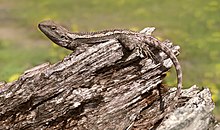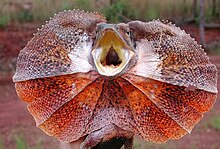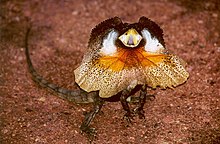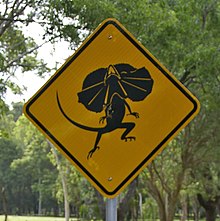frilled lizard
| frilled lizard | ||||||||||||
|---|---|---|---|---|---|---|---|---|---|---|---|---|

Frilled lizard ( Chlamydosaurus kingii ) |
||||||||||||
| Systematics | ||||||||||||
|
||||||||||||
| Scientific name of the genus | ||||||||||||
| Chlamydosaurus | ||||||||||||
| JE Gray , 1825 | ||||||||||||
| Scientific name of the species | ||||||||||||
| Chlamydosaurus kingii | ||||||||||||
| JE Gray, 1825 |
The frilled lizard ( Chlamydosaurus kingii ) is in Australia and New Guinea native, approximately 1 m long expectant kind of Agama (Agamidae). It is the only representative of the thus monotypical genus Chlamydosaurus , and is known for its ability to set up a large ruff like an umbrella. This "collar" is formed by a large skin membrane, which is supported by cartilaginous rods. The sudden expansion of the collar through the contraction of muscles attached to the cartilage rods makes the lizard appear larger and scares off enemies, but it also plays a role in intra-species communication. The frilled lizard is a diurnal tree dweller and feeds on insects. On the ground, she can run upright on her hind legs very quickly.
Frilled lizards are among the best-known representatives of the fauna of Australia and, like kangaroos and the koala, are the landmarks of the country. You are not at risk.
features
Habitus
Collared lizards reach a total length of up to 95 cm, the tail makes up about 2/3 of the total length. Males of this size reach a weight of 900 g. The females have proportionally smaller heads, generally stay smaller and are significantly lighter. A female with a head-torso length of 24 cm weighed 400 g.
In both sexes, the trunk is slightly flattened on the sides. The front legs are short, the rear legs are much longer than the front legs and thus offer advantages in two-legged locomotion. The second toe from the outside is greatly elongated. The body of the frilled lizard is mostly covered with small, rough, keeled scales, some slightly enlarged scales on the neck form a small crest.
Collared lizards are variable in color, the top of the body and the tail can be from orange-brown to gray-brown to completely brown or almost black. The belly is pale yellow.
Construction and functioning of the collar
A characteristic of the species is the eponymous collar, which is folded when at rest and placed on the neck and the front part of the torso. It is formed by a large skin membrane that is stretched between cartilaginous rods. The collar is the same in both sexes in relation to body size, in smaller specimens the ratio of collar size to body size is lower. When stretched, it measures up to 30 cm in diameter. In contrast to the inconspicuous body color, the skin membrane is colored red, black, yellow or white and provided with large, keeled scales. If it is set up, it makes the lizard appear larger and intimidates predators. It is also used as a threatening gesture in male territorial fights.
The collar is set up with the hyoid apparatus. In very simplified terms, it can be said that long cartilaginous appendages extend from the hyoid bone , which can be erected with the help of muscles attached to the collar and lower jaw. The hyoid bone itself is located at the back under the mouth. The cartilaginous rods called ceratobranchials are movably connected to the hyoid bone; they extend backwards out of the body as very pointed cones and are integrated into the skin of the collar. Connected to the ceratobranchial are the muscles of the hyomandibular and the hyoglossus muscle , which attach to the lower jaw and hyoid bone. The sternohyoideus and omohyoideus muscles connect the shoulder girdle and the ceratobranchial. The hyomandibular muscles and the hyoglossus muscle open the collar, the sternohyoideus and omohyoideus muscles close the collar again.
Geographic variation
The populations in northern and northeastern Australia are a little more vividly colored than the animals from Queensland, which usually tend to be a monotonous, gloomy brown or gray. The frilled lizards of the Northern Territory grow slightly larger than the frilled lizards of Queensland. Also in the color of the collar, the northern populations have a vivid red or orange, while the collars of the frilled lizards in Queensland are greyish.
distribution and habitat
The distribution area of the frilled lizard includes northern Australia and a narrow coastal strip of southern New Guinea. In Western Australia , the range of the species is limited to the extreme northeast; in the Northern Territory , frilled lizards are found in the northern parts of the country and in Queensland from Cape York to Brisbane . Within their range, frilled lizards inhabit bushland, open forests and tropical tree savannah, among other things.
Way of life
Activity and physiology
The frilled lizard is a tree dweller. She is a skilled climber who has been observed jumping 1.3m between branches. Frilled lizards spend 90% of their time resting on branches or clinging vertically to tree trunks with rough bark, where they are well camouflaged by their color. Radio-telemetric studies showed that frilled lizards only occasionally went to the ground to hunt or interact with conspecifics, and the specimens examined never stayed on the ground for more than 5 minutes. Frilled lizards prefer trees with thick trunks, poorly branched branches and dark bark, where they are camouflaged from predators such as birds of prey or dogs. On the one hand, they avoid trees with smooth bark, which are difficult to climb, and, on the other hand, especially trees with light bark, on which they have no camouflage.
Frilled lizards are diurnal and actively regulate their body temperature. The animals sunbathe in the early morning until their body temperature is around 2–3 ° C above the ambient temperature after around 40 minutes. Then they retreat into the shade to escape the hot midday and afternoon sun. By simultaneously increasing the air temperature in the shade, the frilled lizard keeps its temperature fairly constant a few degrees above the ambient temperature.
The tropical regions inhabited by frilled lizards are characterized by striking climatic differences between dry and rainy seasons. The frilled lizard meets heat and lack of water in the dry season (May – August) with a series of physiological adaptations. During the dry season, the metabolic rate is reduced by 23%, and the animals spend most of their time motionless in the shady canopy and change trees less often than in the rainy season. The body temperature is kept low in this way and overheating is avoided, and energy-intensive activities such as territorial behavior are relocated to the rainy season. The food intake is reduced by half, but the lizards lose only 1.3% of their weight per month due to severe metabolic restrictions. On the other hand, there is no growth in the dry season.
Natural enemies and avoidance of enemies
In the natural habitat, the frilled lizard is stalked by birds of prey, monitor lizards, snakes and feral dogs. When the lizard feels threatened, it tightens its collar, opens its mouth wide and makes hissing noises. Because of the collar, the lizard seems bigger than it is. When a frilled lizard has to flee, it slides backwards down the tree trunk, turns forwards immediately above the ground and runs on two legs to the next tree. She often starts a fake attack and jumps in the direction of the predator's face in order to surprise him and gain a head start. The two-legged race developed several times independently of one another within the scale creepers and enables faster, more efficient locomotion.
When people approach a frilled lizard sitting on a tree trunk, it first climbs to the other side of the tree. When touched, most of the frilled lizards stay still. When trying to grab them, frilled lizards react with an open collar and sometimes with bites.
nutrition
Frilled lizards hunt mainly in the morning and late afternoon. They are ambulance hunters and observe the surroundings at heights of 2–3 m on a tree trunk or sitting on a branch. If they discover a prey, they climb down their hide and run quickly on two legs to the prey, only to sink back on all fours. Then the prey is caught, chewed and swallowed. Then the lizard climbs back on its hide.
The diet of frilled lizards consists mainly of insects and spiders. In 124 museum specimens examined for their stomach contents, mostly caterpillars (56%) were found as food, weaver ants ( Oecophylla smaragdina ), termites and beetles were also common . Frilled lizards also occasionally rob bird nests. Ants and termites are licked with the tongue in large numbers on ant trails.
In Australia, bushfires are not uncommon and seem to help the frilled lizard to find food. In the weaker fires at the beginning of the dry season, mortality among the frilled lizards is very low as they take refuge in trees. But because the ground vegetation is destroyed by the fire, possible prey animals are without cover. Therefore, frilled lizards can prey on larger numbers and a greater variety of insects. Frilled lizards are also actively migrating into recently burned areas in order to take advantage of the short-term increased food supply. Only during the violent fires at the end of the dry season is the mortality of frilled lizards high and up to 29% of frilled lizards die in the catchment area of the fire.
Social behavior and reproduction
The mating season begins with the rainy season and extends well into it. During the mating season, the males defend their territory intensely with threatening gestures, hissing and fighting. At this time the males occupied territories averaging 2.5 ha and covered 50–80 m per day. The non-territorial females only have about 0.7 hectares of range and cover an average of 23 m every day. In the fight for their territory, the males threaten with their collars and open mouths and bite their jaws into one another. The males often break their jawbones or lose teeth, but the stomach contents of injured specimens show that such injuries do not affect food intake.
The females lay 1–2 clutches of 8–14 eggs per season in a 10–20 cm deep soil nest. In freedom, the pups of a closely observed nest hatched after 69 days, in captivity the pups hatch after 54–92 days. When hatching, the young measure around 4–5 cm head-trunk length. The frilled lizard is one of the reptiles in which the incubation temperature of the eggs determines the sex ( temperature-dependent sex determination ). In one experiment, one clutch was incubated at around 26 ° C, another at 29 ° C and another at 32 ° C. Only males hatched at 29 ° C, and only females hatched in the other clutches.
The young of a clutch stay together in a group for about 10 days. This behavior could serve to protect against attackers, similar to what is known from the green iguana ( Iguana iguana ). Males reach sexual maturity on average with 18.5 cm head-trunk length, females with 17.5 cm head-trunk length. The life expectancy of adult animals living in the wild is estimated at 5–7 years, in captivity, frilled lizards live to be over 10 years old.
Systematics

The first description of Chlamydosaurus kingii was in 1825 by the British zoologist John Edward Gray (1800-1875). He formed the generic name from the Greek words chlamys ("collar") and saurus ("lizard"), the epithet kingii honors Phillip Parker King (1791-1856), Admiral of the British Navy and explorer of the Australian coastline.
Cladistic analyzes of the nucleotide sequences of 2 mitochondrial and 2 nuclear genes place the frilled lizard in the approximately 15 million year old arid region radiation of Australian agamas ( Amphibolurinae ). Apparently there is a particularly close relationship to the amphibolurus species A. muricatus and A. gilberti .
Although individual populations of the frilled lizard can be clearly differentiated in terms of color and morphometry , the genetic diversity of the genus Chlamydosaurus is low and it is undoubtedly monotypical .
Danger
The frilled lizard is in the Red List of Threatened Species of IUCN not threatened as ( least concern noted), the general population trend, however, is unknown ( unknown ). After the cane toad ( Bufo marinus ) was naturalized in Australia, the frilled lizard, as in numerous other animal species, experienced a drop in population, although the decline was locally limited. In New Guinea, the frilled lizard is reproduced for the pet trade.
Cultural references
With the Aborigines
Bones found in Arnhem Land (Northern Territory) prove that the frilled lizard has always been hunted and eaten by the Aborigines . In addition, the frilled lizard was given symbolic meaning: In Aboriginal cosmology, people born under the zodiac sign of the frilled lizard (July 23 to August 22) are seen as particularly striking in their behavior, and at the same time brave and loyal. As a totem , the frilled lizard symbolizes the responsibility that you have to bring up for each of your deeds in the dream time .
The frilled lizards were also integrated into songlines . A frilled lizard is said to have traveled to South Australia from their home in northern Australia together with a short-headed glider ( Petaurus breviceps ). To pass the time, they played the didgeridoo during the trip ; this explains how the southern tribes were able to incorporate elements of the northern tribes and the didgeridoos into their culture. In addition, frilled lizards are among the most common motifs in Aboriginal rock painting .
In popular western culture
In the years 1982–1984, the frilled lizard achieved unusual popularity in Japan . The reason was a frilled lizard who worked in a television advertisement for a car: The Japanese saw the collar bluff as an admirable, artistic self-expression. The frilled lizard was soon as popular as the kangaroo and koala, and numerous Japanese toured Australia to see frilled lizards. Australian 2-cent coins with collar lizards as a motif are said to have achieved prices of the equivalent of one dollar in Japan. These coins ceased to be circulated in 1990 and were taken out of circulation in 1992.
Even in "modern" society, the frilled lizard is symbolic of its homeland and various attributes. In 1986 the frilled lizard became heraldic animal for the Northern Territory Special Reconnaissance Unit , an Australian military unit. The frilled lizard symbolizes the camouflage and defensiveness of this unit. At the 2000 Summer Paralympics in Sydney , a frilled lizard named Lizzie was the mascot. Its collar shape was modeled after the outline of Australia and it was meant to symbolize achievement, strength and pride.
Frilled lizards often appeared in children's films, for example in 1990 in Bernard and Bianca in Kangaroo Land . In Steven Spielberg's classic Jurassic Park (1993), the predatory dinosaur Dilophosaurus is shown with the collar of a frilled lizard, which he sets up like his role model to intimidate enemies. There is no evidence that Dilophosaurus had such a collar. The success of Jurassic Park resulted in increased demand for frilled lizards as pets in the short term.
Web links
- Chlamydosaurus kingii in The Reptile Database
- Chlamydosaurus kingii inthe IUCN 2013 Red List of Threatened Species . Posted by: Doughty, P. & Allison, A., 2009. Retrieved January 31, 2014.
- Video of Chlamydosaurus kingii defensive behavior on nationalgeographic.com
literature
- A. Hauschild, H. Bosch: Bearded dragons and frilled lizards. 4th edition. NTV, Münster 2003, ISBN 3-931587-17-7 , pp. 67-77.
- L. Toro: Chlamydosaurus kingii (PDF; 17 kB). James Cook University , 1999 ( Herpetofauna of North Queensland ).
swell
- ↑ a b Hauschild, Bosch (1997), p. 67.
- ↑ a b Hauschild, Bosch (1997), p. 69.
- ↑ a b c Toro (1999), p. 1.
- ↑ Hauschild, Bosch (1997), pp. 69-70.
- ↑ a b c d R. Shine: Function and evolution of the frill of the frillneck lizard, Chlamydosaurus kingii (Sauria: Agamidae) . In: Biological Journal of the Linnean Society. 40: 11-20 (1990).
- ↑ a b c d e f S. Wilson, G. Swan (2010): A complete guide to reptiles of Australia . 3. Edition. New Holland Publishers, Sydney / Auckland / London / Cape Town 2010, ISBN 978-1-877069-76-5 , p. 355.
- ^ S. Tomo et al .: The Muscles of Frill Erection in the Frilled Neck Lizard (Chlamydosaurus kingii) . In: Acta Anatomica Nipponica 76 (1) 2001, p. 128.
- ↑ a b c d e f Hauschild, Bosch (1997), p. 70.
- ↑ a b c Hauschild, Bosch (1997), p. 71.
- ↑ a b A. D. Griffiths: Population size and habitat management of frillneck lizards in a suburban park: Yanula Park, Darwin . Report to Darwin City Council, Charles Darwin University, 2006. ( full text ( memento of March 2, 2011 in the Internet Archive ); PDF; 337 kB)
- ↑ a b c d e f Toro (1999), p. 2.
- ↑ Toro (1999), pp. 1-2.
- ↑ P. Aerts include: Bipedalism in lizards: whole-body modeling Reveals a possible spandrel . Philosophical Transactions of the Royal Society, London 2003, B 358, pp. 1525-1533.
- ↑ a b Hauschild, Bosch (1997), p. 73.
- ^ Hauschild, Bosch (1997), p. 72.
- ↑ a b c Toro (1999), p. 3.
- ↑ PS Harlow, R. Shine: Temperatue-dependent sex determination in the Frillneck lizard, Chlamydosaurus kingii (Agamidae) . In: Herpetologica. 55 (2) 1999, pp. 205-212.
- ^ Hauschild, Bosch (1997), p. 74.
- ↑ AF Hugall, R. Foster, M. Hutchinson, MSY Lee (2008): Phylogeny of Australasian agamid lizards based on nuclear and mitochondrial genes: implications for morphological evolution and biogeography. In: Biological Journal of the Linnean Society. 93 (2008), pp. 343-358.
- ↑ Mitzy Pepper, David G. Hamilton, Thomas Merkling, Nina Svedin, Bori Cser, Renee A. Catullo, Sarah R. Pryke and J. Scott Keogh. 2017. Phylogeographic Structure Across One of the Largest Intact Tropical Savannahs: Molecular and Morphological Analysis of Australia's Iconic Frilled Lizard Chlamydosaurus kingii . Molecular Phylogenetics and Evolution. 106; 217-227. DOI: 10.1016 / j.ympev.2016.09.002
- ↑ Chlamydosaurus kingii in the endangered Red List species the IUCN 2010. Posted by: Doughty, P. & Allison, A., 2009. Retrieved on January 12 of 2010.
- ↑ M. Reid: Mythical Star Signs . Lulu Enterprises, 2007, ISBN 1-84753-623-9 .
- ^ DB Rose: Dingo Makes Us Human: Life and Land in an Australian Aboriginal Culture . Cambridge University Press, 2000, ISBN 0-521-79484-6 .
- ^ Hauschild, Bosch (1997), p. 77.
- ↑ Two cents . Australian Government, Royal Australian Mint , accessed January 12, 2011 .
- ^ Early History - World War II . (No longer available online.) Australian Government, Department of Defense , archived from the original September 27, 2011 ; accessed on January 12, 2011 (English).
- ^ A Brief History of the Olympic and Paralympic Mascots . (No longer available online.) The Beijing Organizing Committee for the Games of the XXIX Olympiad , Aug 5, 2004, archived from the original on Aug 13, 2011 ; accessed on January 12, 2011 (English).
- ^ JB Bennington: Errors in the Movie "Jurrasic Park" . In: American Palaeontologist. 4 (2) 1996, pp. 4-7.
- ^ B. Christy (2008): The Lizard King: The True Crimes and Passions of the World's Greatest Reptile Smugglers . Twelve, New York, ISBN 978-0-446-58095-3 .



